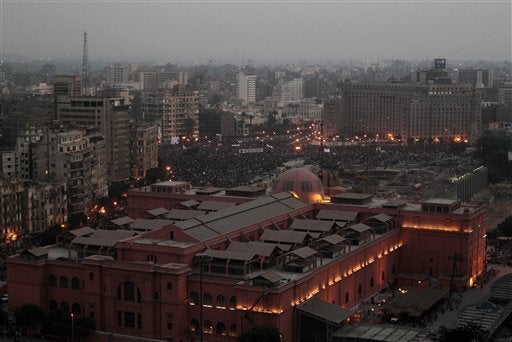
The stunning events that continue to unfold at Tahrir Square in Cairo, Egypt feature a building as one of the major players: The Museum of Egyptian Antiquities. Particularly throughout the recent days of clashes, this repository of one of the world's most deeply historical legacies stood vulnerable to fires and looters, quietly towering over both citizen protesters and government goons as a uniquely aesthetic as well as cultural witness and judge.
Ghosts are far more palpable here than superstitions in the mind of an impressionable child: the unseen remains of Pharaohs clearly exerted a psychological force that cut through Wednesday's primitive street fighting. Last week, as Mubarak's National Democratic Party headquarters burned across the street, a group of irregulars from among the citizenry occupying the Square gathered to repulse a crowd of would-be looters. Unlike Bagdad's National Museum of Iraq, where "stuff happened," count this as a victory for the cultural heritage not just of a nation but of the world. Even two mummies initially reported as having been decapitated by looters turned out to be just fine.
It used to be that even here in youthful America time was a determining factor in our consideration of what was deemed "museum quality." The Neo-Classical museum buildings of a century ago drew the public to view the Old Masters, and what living artists produced was a seldom to be seen sideshow. The rise of a network of contemporary art museums that followed the example of German Kunsthalles during the last 30 years has forever altered the way we discourse with history, essentially shaping it on the fly as we consider one subject after another. The idea that we stand in awe of a set of fixed achievements implies a diminishing of our own potential. Given the opportunity to preserve the living remnants of those achievements puts us on a more even footing with them.
Now it is the assumed task of the Arab world -- Egypt, for the moment at least, spearheading the manner by which it happens -- to reshape their political culture on the fly. The act of protection afforded the objects stored in a single building provides more than testimony for the power of cultural heritage. It was an act of self-awareness in the midst of chaos. What they will become is very likely made better by that act of cultural preservation, and it goes far beyond the continued existence of the objects in that museum. Yes indeed they give the Egyptian people and, in this case, the family of nations an important focal point of shared commonality. Beyond this, for Egyptians this act of selfless preservation provides a hopeful symbol that this source of pride will translate into a leadership able to serve that nation with analogous selflessness. The image stands as a reference point by which the world will judge them.